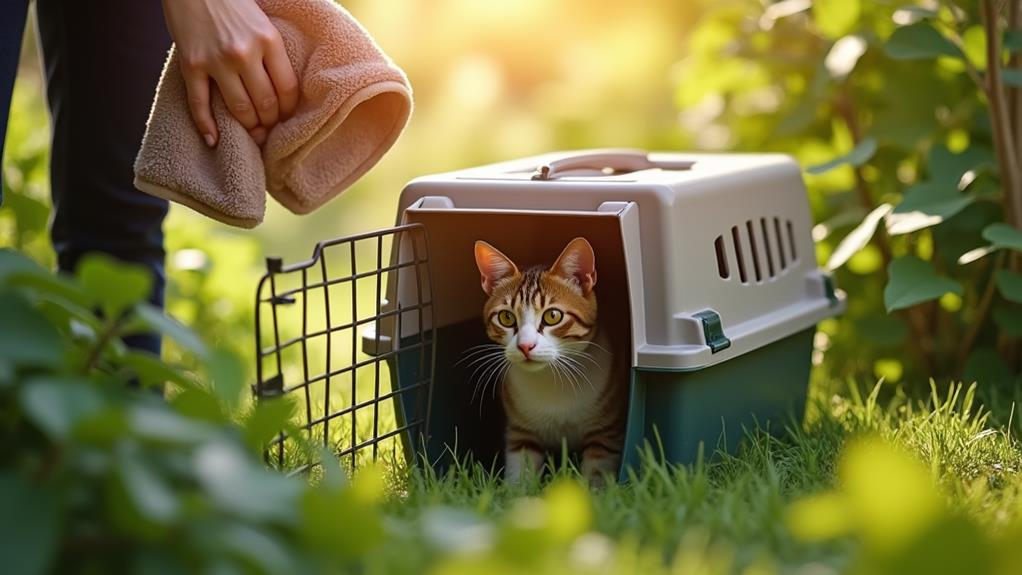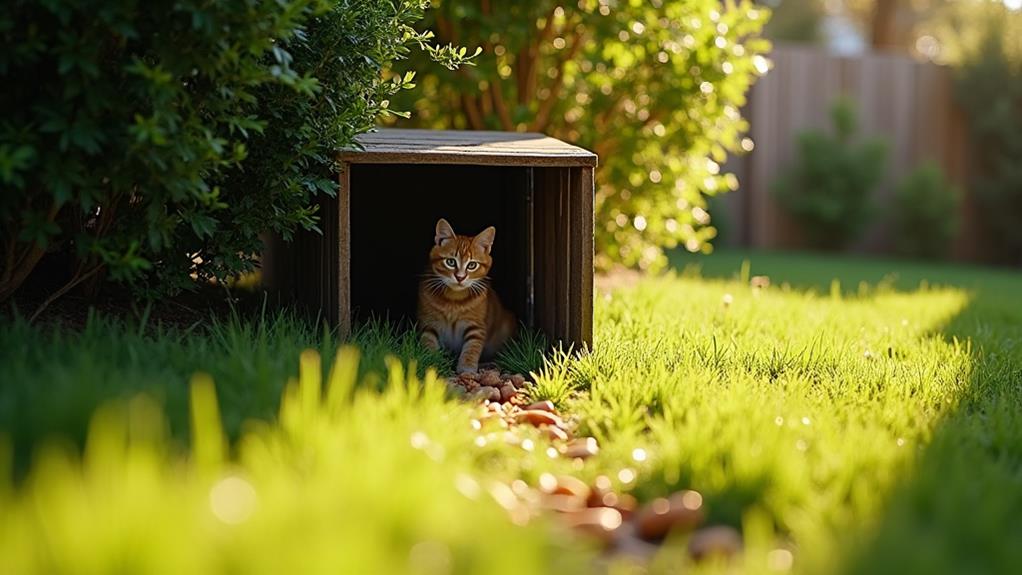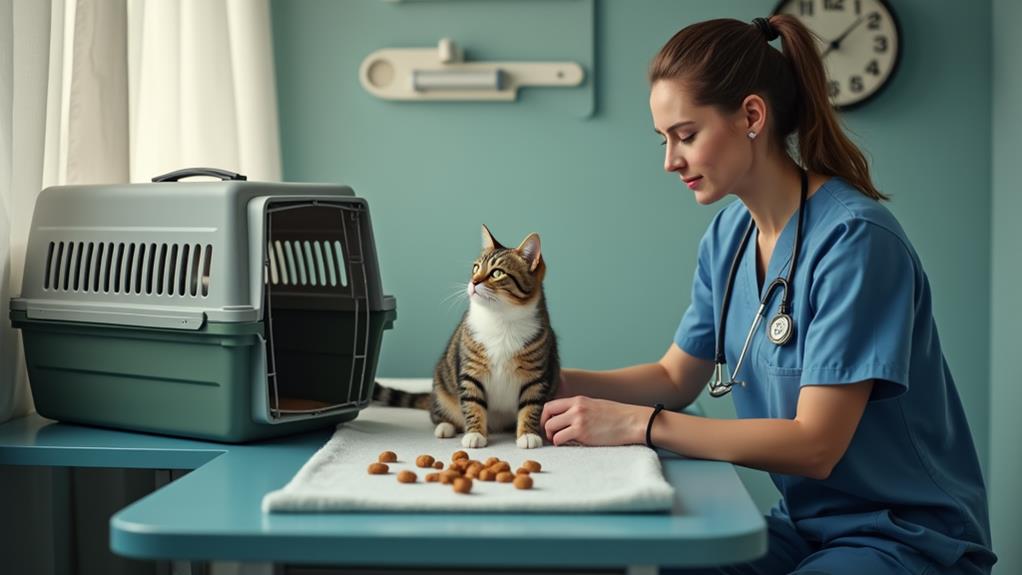How to Safely Get a Feral Cat to the Vet: A Step-by-Step Guide

To safely get a feral cat to the vet, start by understanding their wary nature and avoid direct interaction. Research TNR programs near you and gather a humane trap with strong-smelling bait. Establish a feeding routine to familiarize the cat with the trap. Line the trap with soft material and cover it to reduce stress. Position it in areas the cat frequently visits and monitor it often. When transporting, secure the trap in your vehicle, maintaining a calm atmosphere. Schedule a vet appointment in advance, noting the cat's feral status for gentle handling. There's more to ensuring a smooth process ahead.
Understanding Feral Cats
In relation to understanding feral cats, it's important to recognize that these animals aren't just strays but have been born and raised without any human socialization. This means they are often shy and wary, displaying behaviors that resemble wild animals more than domestic pets. When you encounter feral cats, you'll notice they tend to avoid human interaction, relying on their self-sufficiency to survive.
To effectively manage feral cat populations, it's imperative to take into account humane treatment through spaying and neutering. TNR programs, like those supported by Alley Cat Allies, are significant. These programs help trap a feral cat, provide medical care, and return them to their habitat. This approach curbs the potential for thousands of offspring, emphasizing the importance of population control.
Community involvement plays a noteworthy role in the welfare of feral cats. Establishing a Community Cat Colony with designated caretakers can improve their health and longevity. A feeding station helps maintain a stable food supply, encouraging cats to stay within monitored areas. By understanding these cats' needs and behaviors, you can contribute to more effective and compassionate strategies for their management and care.
Preparing for Trapping
Why is preparation so crucial in relation to trapping feral cats? Proper preparation guarantees a smoother, safer trapping process for both you and the cat, reducing stress and potential injury. Before you set out to trap a feral cat, research your local shelters and community organizations that support trap-neuter-return (TNR) efforts. They can offer valuable guidance and resources.
Start by assembling a trapping kit. You'll need a humane trap, preferably 36 inches long by 12 inches high, to safely accommodate the cat. Verify the trap is functioning correctly to avoid harming the cat. Include strong-smelling bait like canned tuna or sardines to lure the cat into the trap. Wear gloves to handle the trap and label it for identification.
Get the feral cat accustomed to the trap's presence by setting a consistent feeding schedule in the area. This way, the cat gets familiar with the trap and views it as a source of food. Limit feeding times to encourage the cat's attendance.
Setting Up the Trap

Now that you've prepared for trapping, it's time to set up the trap itself. Choose a humane trap that's at least 36 inches long and 12 inches high. This guarantees the feral cat is comfortably accommodated and the trap closes securely. Line the bottom with newspaper, towels, or cardboard. This provides a soft surface, reducing stress during transport.
Place the trap in an area where the feral cat frequently visits. Use strong-smelling bait like canned tuna or sardines to attract the feral cat. Put the bait at the back of the trap to guarantee the cat fully enters. Once the cat is inside, cover the trap with a blanket or towel. This creates a secure, calm environment and helps reduce stress.
It's vital to check the trap frequently. A cat left inside for too long could face extreme weather or heightened stress. While you're monitoring, remember to provide water nearby to guarantee the trapped cat doesn't get dehydrated. By doing these steps, you're effectively preparing for a safe transport to the vet and ensuring the feral cat's well-being throughout the process.
Safe Transportation
Transporting a feral cat safely to the vet requires careful planning and consideration. Initially, use a sturdy, humane trap specifically designed for cats. This guarantees their safety and comfort during transportation. It's essential to cover the trap with a blanket or towel to create a secure environment, minimizing stress and helping to maintain a calm atmosphere for the cat.
Once the cat is trapped, secure the trap in your vehicle. Avoid placing it in open truck beds or unsecured areas where it could slide or tip over. A stable placement will prevent unnecessary movement during transit. Keep the car temperature controlled, ideally around 70 degrees Fahrenheit, to make sure the cat remains comfortable. A consistent temperature helps reduce stress and prevents overheating or chilling.
Throughout the expedition, monitor the cat closely. Watch for signs of distress or illness, such as heavy panting or lethargy. Avoid loud noises or sudden movements in the vehicle, as these can increase the cat's anxiety. By taking these precautions, you'll guarantee the feral cat experiences minimal stress and arrives at the vet in good condition, ready for a safe and calm examination.
Veterinary Visit Essentials

When preparing for a veterinary visit with a feral cat, it's important to confirm the cat is secured in a humane trap to prevent any escapes. This minimizes stress during transport and guarantees the cat's safety. Schedule the veterinary appointment in advance, confirming the clinic is equipped to handle feral cats. Make certain they have protocols in place for their specific care and handling needs.
Prepare the trap by lining it with clean bedding, offering comfort, and cover it with a blanket to keep the environment calm. This setup can help reduce the cat's anxiety during transport. Gather any relevant information about the cat's health history or observed behaviors. Sharing this with the veterinarian will provide significant insights during the examination and care process.
Upon arrival at the clinic, inform the staff about the cat's feral status. This communication is important as it allows them to take appropriate measures for safe handling and examination. The clinic staff needs this information to provide the most effective care. By confirming these steps, you're contributing to a smoother veterinary appointment, ultimately benefiting the feral cat's well-being.
Post-Vet Care and Release
Once the veterinary visit concludes, you'll need to focus on the post-care and release of the feral cat. Proper post-vet care is vital for the cat's health and safety. Confirm you release the cat back to its original location within 24 hours post-surgery, provided it's alert and stable. This helps the cat smoothly shift back to its familiar environment. Here are three significant steps to follow:
- Provide Necessities: Immediately upon release, offer fresh water and soft food. This aids in recovery from anesthesia and encourages the cat to stay close, allowing you to monitor its health.
- Monitor Health: Keep an eye on the cat for several days after release. Watch for any signs of complications such as lethargy, loss of appetite, or unusual behavior that might indicate distress or health issues.
- Confirm Safety and Routine: Make certain the release area is safe and familiar to the cat. Maintaining a consistent feeding schedule will help the cat feel secure and encourage its return, allowing you to monitor its rehabilitation and overall condition.




